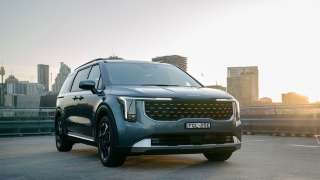As we’ve already pointed out, our price benchmark for this test was the $30,000 mark. Both the Skoda Kamiq 85TSI and Ford Puma (the base model is simply called Puma) have the same starting price of $29,990, but the Puma's is an MSRP price, before on-road costs, where the Kamiq 85TSI's sub-$30K sticker is a drive-away deal (its official MSRP is $27,990 for the auto tested here).
Meanwhile our third contender is the Toyota Yaris Cross. We’ve chosen it in mid-grade GXL trim, with the mid-spec front-wheel drive hybrid engine option. It wears a slightly taller MSRP than the other two cars here at $31,990. Now, to be clear, we could have chosen a Yaris Cross GXL without the hybrid drive option ($29,990) but we really wanted to see if Toyota’s signature hybrid drive would be a silver bullet here, and the GXL trim is most reflective in spec level against the other two cars.

In terms of multimedia, all cars here deliver. Both the Puma and Kamiq have 8.0-inch multimedia touchscreens, while the Yaris Cross has the smallest unit at 7.0-inches. All are capable of supporting Apple CarPlay and Android Auto connectivity, but only the Kamiq offers it wirelessly (albeit as part of a $3800 Tech Pack).

Interestingly the only car here to not offer wireless phone charging as standard is the Yaris Cross. The Skoda does away with old-school USB-A ports, swapping them out for a USB-C only setup, so you might want to invest in a few converters.
When it comes to built-in navigation the Puma and Yaris Cross have it standard at this grade, but it again falls into the Skoda’s Tech Pack.

All cars have digital displays in their driver’s instrument binnacle, but the Ford Puma misses out on a fully digitised dash, making do with old-school dials. The Yaris Cross has quirky digital elements, while the Skoda thoroughly impresses with its fully digital ‘Virtual Cockpit’ it shares with VW and Audi products.
All cars on this test get push-start ignition, but annoyingly the Puma is the only car not to pair this with keyless entry.
In terms of wheel size, all three cars are different. The Kamiq has massive 18-inch alloys, even here in the base grade, while the Puma gets small-looking two-tone 17-inch rollers, and the Yaris Cross looks decidedly base on its 16-inch single-colour rims.

Each car has its own unique addition to the spec list. The Skoda adds the luxury of a powered tailgate, rare at this price, while the Puma bizarrely has standard message seats for the front two occupants. Meanwhile, the Yaris Cross is the only car in this test to have a front- and top-down surround view camera suite.

All cars here make do with manually operated cloth seats, but all also impress with standard LED headlights.
Finally, each car also has a competitive safety suite, with some items notably omitted or option-packed away. Read on to the Safety section later in this review for more on that.

A winner here? This section is probably the closest of them all, but I’d give the Skoda a nudge for its impressive array of tech and practicality inclusions over the others. Plus, if you really want you can option the handful of items it misses out on.
| Kamiq | Yaris Cross | Puma |
Price | $29,990 | $31,990 | $29,990 |
Multimedia screen | 8.0-inch | 7.0-inch | 8.0-inch |
Digital instruments | Full | Full | Partial |
Apple CarPlay/Android Auto | Yes (wireless CarPlay optional) | Yes | Yes |
Wireless phone charging | Yes | No | Yes |
Built-in sat-nav | Optional | Yes | Yes |
Keyless entry & push-start | Yes | Yes | Push-start only |
Motorised tailgate | Yes | No | No |
Headlights | LED | LED | LED |
Wheel size | 18-inch | 16-inch | 17-inch |
Cruise control | Adaptive | Adaptive | Standard (adaptive optional) |
Climate control | Dual zone | Single zone | Single zone |
Parking sensors | Rear | Rear | Front (optional) + rear |
Parking cameras | Rear | Rear + top-down + front | Rear |
| Kamiq 85TSI | Yaris Cross GXL 2WD Hybrid | Puma |
Price and features | 8 | 7 | 8 |

























































 Haval Jolion
Haval Jolion